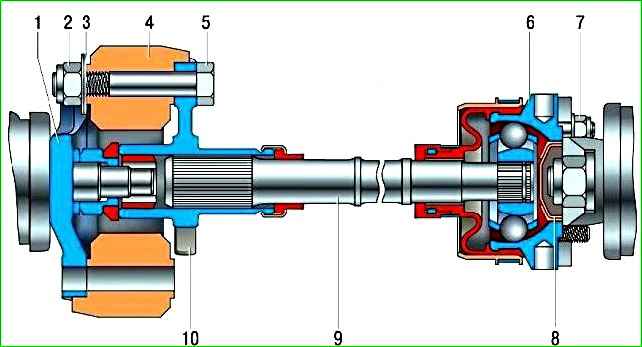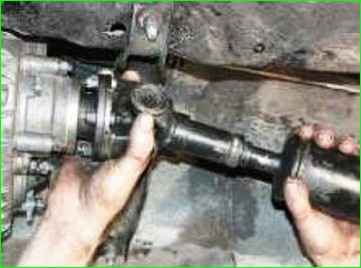The driveshaft is designed to transmit torque from the gearbox to the transfer case and from the transfer case to the front and rear drive shafts

The propeller shaft of the VAZ-2123 consists of an intermediate 2 (Fig. 1), front 1 and rear 4 propeller shafts.
The intermediate propeller shaft is made of a rod with splines on both ends.

At one end of the shaft (from the gearbox side) a flange 10 (Fig. 2) is installed, which is connected to flange 1 of the secondary shaft of the gearbox through an elastic coupling 4.
The splined connection of the elastic coupling flange and the shaft is sealed with an oil seal.
At the other end of the shaft (from the transfer case side) a constant velocity joint is installed.
The housing 6 of the constant velocity joint is attached to the flange of the input shaft of the transfer case using studs.
The design of the front and rear cardan shafts is the same. The shaft is a thin-walled steel pipe.
A splined tip is welded to one side of the pipe, on which a sliding fork of the universal joint is installed.
The splined connection of the shaft and fork is sealed with a gland. On the other side, the fork of the universal joint is welded to the pipe.
Both universal joints are connected to flanges, one of which (from the pipe side) is attached to the flange of the front axle reducer, and the other to the flange of the driven shaft of the transfer case.
Each universal joint consists of two forks connected by a crosspiece.
Some of the vehicles produced can be equipped with front and rear universal joint shafts with constant velocity joints. Their design is similar to the design of the front wheel drives.
Checking the serviceability of the cardan transmission on the car
Check the cardan transmission from underneath the car, located on a lift or inspection pit.
The gearbox and transfer case must be in neutral.
Check the tightness of all threaded connections, the condition of the joints and the rubber mass of the flexible coupling of the intermediate shaft (by external inspection).

Take hold of the shaft near the joint being checked with both hands.
Using short sharp movements, rock each cardan shaft in directions perpendicular to its axis.
No noticeable play in the joints is allowed.

Repeat the check for all cardan joints
Using short sharp movements, turn the cardan shaft around its axis in both directions, holding the cardan joint fork-flange from rotation.
Repeat the check on the remaining cardan joints.

No noticeable circumferential clearances are allowed





